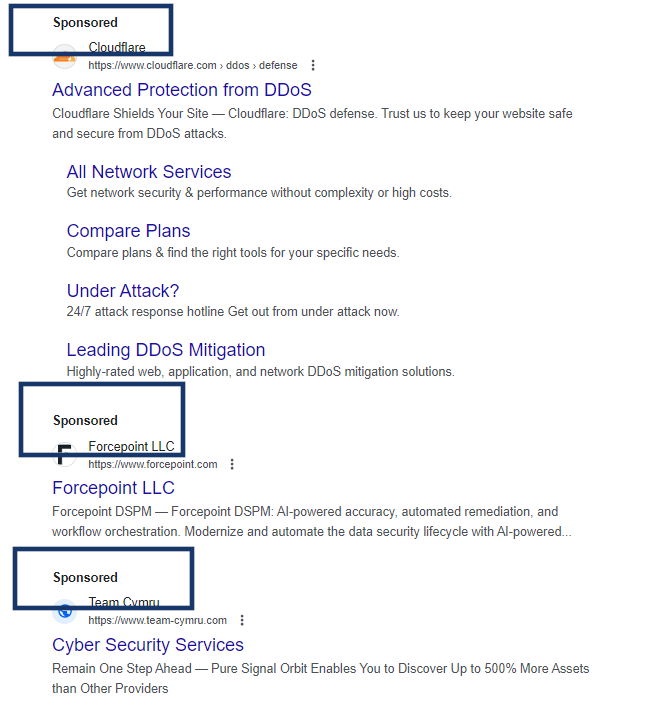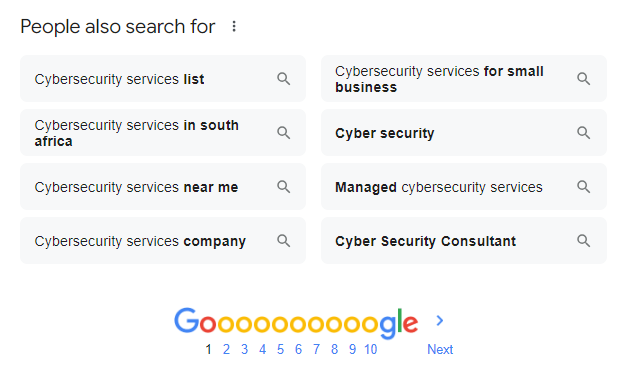- Home
- Industries
- Tech
- cybersecurity
- PPC for Cybersecurity: How To Get Real Results
PPC for Cybersecurity: How To Get Real Results
Launching a successful pay-per-click (PPC) campaign for the cybersecurity industry requires the right targeting, message, and strategy. As a cybersecurity professional, you are well-versed in the niche work required for safeguarding networks and threat detection. Getting PPC for cybersecurity could be the solution you need to boost your visibility and give you the results you want — like more clients and revenue.
-
insights from 85,500+ hours of technology marketing experience
This article will explore the different challenges you will face, how to resolve or find solutions for those challenges, and how to get going on your PPC campaign.
If you are new to PPC, then we suggest reading from start to finish. But if you are already familiar with the concept of PPC, then you can jump to the action on the set-up with:
What is PPC for cybersecurity?
PPC is an advertising strategy where every time a user clicks on an advert, the advertisers have to pay a fee. With PPC, you can buy top spots and positions, rather than attempt to earn them organically, which takes time. PPC ads can appear on search engines, social media platforms and other websites.
Here’s what a PPC ad looks like in search engines:

How does PPC work for cybersecurity?
Advertisers bid on keywords or phrases relevant to their target audience with PPC. When a user searches for those terms, the search engine displays the ad at the top or bottom of the search results. The advertiser must pay each time a user clicks the ads, hence the name “pay-per-click.”
You can set your budget to a maximum and daily limit, giving you control of your budget. Once you know your audience, you can target them directly with a clear, engaging message and reel them in.
PPC terms to know
When browsing PPC campaigns and getting yourself familiar with the concept, there are some PPC terms that you are going to see keep cropping up. Here are a few of the common PPC ones with explanations for your convenience:
- Cost per click (CPC): The amount you pay each time someone clicks on your ad.
- Click-through-rate (CTR): The percentage of people who click on your advert after seeing it.
- Conversion rate (CVR): The percentage of users who complete a desired action, or convert, after clicking your ad. A desired action is anything you have chosen, such as signing up for a newsletter or downloading a white paper. A higher CVR means your ad is effective.
- Customer acquisition cost (CAC): The total cost of an acquired new customer, including the PPC spend, marketing costs, and sales efforts.
Why use PPC marketing for cybersecurity businesses?
There are a number of strategic reasons why your business will consider investing in cybersecurity ads. A few of those reasons include:
You can measure your ROI and lead generation
PPC for cybersecurity campaigns offers clean, measurable results, which a data-driven business like yours will appreciate. You can track key performance indicators (KPIs) such as the CTR and CVR.
This data-driven approach can allow you to fine-tune campaigns in real-time for better performance and higher ROIs. Plus, you can do this while fully controlling your budget to ensure it is spent effectively.
You can target your audience specifically
With PPC for cybersecurity, you can reach your highly specific audience by targeting well-researched keywords, demographics, and behaviors.
Potential customers actively searching for cybersecurity solutions or related information will see your ads only. This feature cuts out a lot of the broad audience and focuses purely on potential clients, increasing the likelihood of lead conversion.
You can boost your business immediately
PPC allows you to bid and pay for top spots immediately. By placing your ad at the top of search results or in key positions, you can be as visible as the top organic search results. However, paid advertising does it in a matter of hours.
Organic SEO strategies for cybersecurity companies are a sure way of building stable and sustainable traffic, but these strategies do take time to build momentum. While your team is working on it, get a cybersecurity marketing agency like WebFX to do your PPC and paid advertising strategy. This will put your company ahead of competitors and give you quick visibility today while your SEO foundation grows.
Challenges that PPC marketing can help cybersecurity companies with
Here are some advantages to get you excited about PPC:
- Compete with industry giants: Do competitor analysis to investigate what keywords your competitors are doing. While some of these might be out of your budget, it does give you the opportunity to find “keyword gaps” that you can use cost-effectively.
- Spread awareness with sponsored positions: Even if users don’t click on your ad, simply having your business name appear in search results can increase awareness.
- Expand your reach with clients: PPC is an effective tool for generating leads. You can direct the traffic to a well-crafted landing page and capture information through forms, download requests, or booking consultations.
How to set up PPC for cybersecurity campaigns in 5 steps
Ready to get going? You can sit with your own marketing team to create a PPC strategy or with a cybersecurity marketing agency, like WebFX, to start the process.
Here are 5 steps to get your successful PPC campaign off the ground:
1. Identify your target audience
Take your time identifying your target audience. You can ask your sales team for information, conduct surveys, or conduct online research. Work out your clients’ demographics and pain points so that you have all the information you need to target them with your marketing message.
Create customer profiles. Identify where they all gather naturally, like what social media platforms they use or the influencers they follow. Conduct a competitor analysis from other companies that offer similar services or products.
2. Find your keywords
Another area that you should take time with is your keywords. Keywords form the foundation of your PPC campaigns, your paid advertising, and your organic SEO strategy. They are a building block to creating your overall marketing strategy.
A good place to start building your keywords list is to look at your core services, such as “network security” and “data protection.” These will give you your seed keywords.

From here, you can grow your long-tail keywords using a keyword research tool. You can also use Google and look at the ‘related’ search terms or the questions users ask Google for some ideas.
3. Create engaging cybersecurity ads
Once you know who are targeting and the keywords you want to use, it’s all about identifying your audience’s key concerns. For example, your clients could focus on issues like data breaches, regulatory compliance, and threat prevention.
Tailor your marketing messages to address these concerns and customize the tone of the message to resonate with the target audience. Remember to be direct and clear. You want the heading to convey the value of your service immediately.
4. Polish the landing pages
The message on your landing page must reflect the content of your ad. It should also capture the same branding, color, and imagery so that the client feels like it is all cohesive and professional. Include a strong call to action (CTA) to capture leads.
Everything must be designed for a smooth user experience. The landing page must be fully responsive and quick to load. There must be no issues or distractions at this point of the experience. Remove anything that could distract the user, as, at this point, it should be a focused, one-page experience with a single goal.
5. Link up your analytics and start tracking
The last step is to make sure everything is tracked so that you can learn through this experience or optimize it, if needed, during the campaign. Don’t forget also to try A/B testing with different landing pages and messages to ensure that you spend your budget on the most successful version.
A/B testing involves first testing multiple designs and landing pages on a smaller segment audience. The higher-performing advert is then used in the larger campaign, allowing you to optimize results.
Work with a cybersecurity marketing agency that understands revenue growth
We’ve covered many basics in this article about how to get started with your PPC journey in the cybersecurity industry. You are probably wondering about now how much this all costs. Use the calculator below to estimate your PPC and Google Ads costs right now for free. If you want to break down all the elements, give this PPC strategy article a read.
PPC Pricing Calculator
Alternatively, if you want to talk to someone specifically about your company and if PPC will work for you, then talk directly to a strategist on 888-601-5359 or use our online form.
We Drive Results for Tech Companies
- 360+ tech industry experts
- 24 million leads generated for clients



Table of Contents
- What is PPC for cybersecurity?
- How does PPC work for cybersecurity?
- Why use PPC marketing for cybersecurity businesses?
- Challenges that PPC marketing can help cybersecurity companies with
- How to set up PPC for cybersecurity campaigns in 5 steps
- Work with a cybersecurity marketing agency that understands revenue growth
We Drive Results for Tech Companies
- 360+ tech industry experts
- 24 million leads generated for clients



Explore our technology case studies
Read our case studies for a more in-depth look at our results.
Solving key challenges for tech companies
Our website isn’t driving enough traffic
Struggling to bring prospective clients to your website? Our team can help you increase your rankings in search results, meeting your audience when they’re looking for your solutions, so you drive more web traffic, leads, and revenue.

We’re not selling our software or services
Launch data-driven marketing and advertising campaigns with your dedicated WebFX team that reach the people most likely to invest in your solutions. The result? You drive more revenue and help achieve your business’s biggest objectives.

We’re struggling to attract new clients
Are you struggling to build your brand awareness and online visibility so more potential clients find you online? With our suite of digital marketing services, you’ll expand your reach and promote your solutions where your audience spends their time online.

We’re not retaining our clients
At WebFX, our marketing experts help you implement effective strategies and processes that help you deliver an amazing customer experience that builds brand loyalty and keeps your company at the forefront of clients’ minds instead of competitors.


